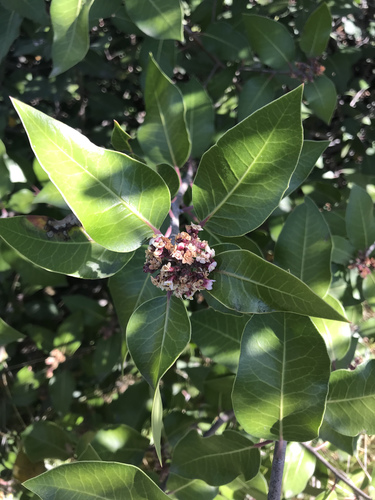Observation of the Month: Lemonadeberry x Sugar Bush Hybrid (Anacardiaceae)
To see the photos, you can view this post on Facebook:
Lemonadeberry × Sugar Bush Hybrid (Rhus integrifolia × ovata) https://www.inaturalist.org/observations/73773132 by @madge

Lemonadeberry (Rhus integrifolia) and Sugar Bush (Rhus ovata) are common shrubs in San Diego County. Lemonadeberry is found in coastal sage scrub habitat near the coast and inland to the lower foothills. Sugar Bush tends to be found in more inland areas, in the higher foothills and mountains in chaparral habitat. In some parts of the county, both species can be found growing in close proximity, and in those areas, hybrids between the two are also often present.
Hybrids show characteristics that are intermediate between the two parent species. Some of the characteristics of Lemonadeberry and Sugar Bush that are used to distinguish between the species and their hybrids include the size, shape, and structure of leaves and whether there are glands on the margins of the sepals.
Lemonadeberry has leaves less than 2 ½ inches long that are generally flat. The leaves are egg-shaped or have a narrow oval shape with one end slightly larger, but in either case, the leaf is attached at the more narrow end. The margins of the leaves of Lemonadeberry may have small teeth or may be completely smooth. The sepals of Lemonadeberry have a marginal fringe of mostly glandular hairs visible under magnification.
 Rhus integrifolia (lots of glands on margin of sepal)
Rhus integrifolia (lots of glands on margin of sepal)
Sugar Bush has generally larger leaves (usually about 2 to 4 inches long) that fold along the midrib, like a taco. The leaves are either egg-shaped or shaped like an equilateral triangle and are attached at the wider end. The sepals of Sugar Bush have a marginal fringe of hairs that are not glandular.
 Rhus ovata (hairs but no glands on margin of sepal)
Rhus ovata (hairs but no glands on margin of sepal)
A Lemonadeberry × Sugar Bush hybrid is likely to have leaves that are larger than a typical Lemonadeberry, but smaller than a typical Sugar Bush. The leaves may be wavy – neither flat nor folded—or have a shallow fold. A few scattered teeth are usually present along the leaf margins. Leaf shape may vary from oval to elliptic with the leaf tip being rounded or pointed. Sepals usually have at least some glandular hairs at the margin.
 Rhus integrifolia x ovata (hairs and some glands on margin of sepals)
Rhus integrifolia x ovata (hairs and some glands on margin of sepals)
When one sees a familiar species that looks a little different, it is easy to conclude that it might be a hybrid. With Rhus integrifolia, we expect to see leaves with teeth and when they are not present, thoughts may turn to Rhus integrifolia × ovata, but absence of teeth alone cannot be relied on for identification of Rhus ovata or hybrids since the leaves of Rhus integrifolia may have smooth margins. Hybrids are most likely to be found in mid-elevations (although one may find planted specimens at any elevation). Be sure to check other characteristics, such as size, shape, and folding of the leaves (it’s always best to look at mature leaves near the base of a branch), and presence or absence of glandular hairs on the margins of the sepals.
(Photos of sepal margins taken by Dr. Jon Rebman of herbarium specimens under microscope.)



